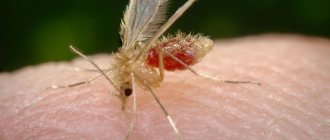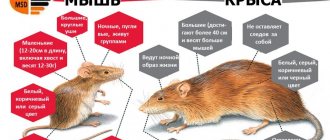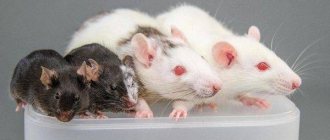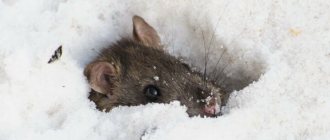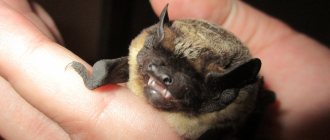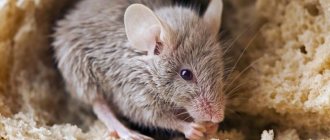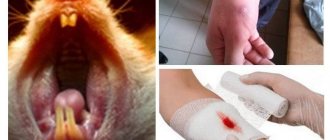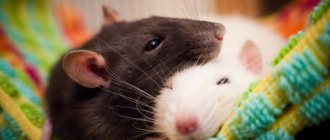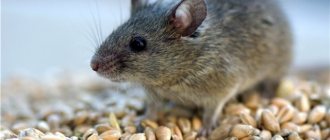Many people living in private homes are interested in the difference between a mouse and a rat. The point is not that both of them carry various infections, but that one should begin to fight rodents by determining their type. Thanks to this, it will be possible to choose an effective way to destroy them. To understand the differences between a mouse and a rat, you should know the structural features of the body of these similar animals.
Many people living in private homes are interested in the difference between a mouse and a rat.
Differences in appearance
Due to the external similarity, not every person can recognize the differences between a mouse and a rat. Both rodents have gray fur and a long tail. But there are also many differences in their appearance.
Dimensions
Size is the main difference by which these rodents can be distinguished. The average body length of a baby rat is 7–10 cm, the same as an adult mouse. And rats grow up to 25 cm.
The weight of rodents also differs significantly. Rats are larger and therefore heavier than mice. An adult weighs on average 220–250 g. Moreover, males are much larger than females. Their weight with proper nutrition can reach 450 g. An adult mouse weighs only 45–85 g.
Important! In rare cases, rats can grow to gigantic sizes. In nature, there were individuals whose weight exceeded 1 kg. The length of such a rodent can reach 40–50 cm.
Head and ears
Mice differ from rats in the shape of their heads. In rats, the muzzle is strongly extended forward. And in mice it is slightly shorter and has a triangular shape. Rats have much smaller eyes.
Outwardly, they resemble black beads. Mice have large and mobile eyes. Rodents also rotate their heads differently. To do this, rats need to move their torso, and mice can twirl it without the participation of the body.
Mouse
Rats and mice differ from each other in the shape of their ears. In large rodents they are small, triangular and covered with sparse villi. In some subspecies their ends are blunted.
A mouse differs from a rat in having larger, movable ears that it can move. Rats can't do that. Mice have round ears and no hair on them.
Paws and tail
Due to their size, rats move primarily in horizontal places. To find food and escape from predators, they need to run fast and jump high. Therefore, their paws are powerful and muscular, and between the toes there are rough outgrowths of skin visible - these are rudimentary membranes.
Due to their light weight, mice can easily climb vertical surfaces. They are helped in this by small and flexible paws with tenacious claws.
Mouse
Rats have a short tail. It is thick and bristly, there is no hair on it. Its size is approximately half the length of the individual’s body. Mice have a thin tail. Its length is at least ¾ of the body size.
Rat
Wool
Rats have dark gray, dirty-colored fur. The hairs are thick and coarse, and the skin underneath is easily visible.
Important! Decorative individuals have softer wool. Its color depends on the species. Pet stores sell white, red, gray and black rodents. There are also individuals with a hood of a different color.
Decorative rats
The fur of mice is softer and silkier. These rodents have a smoky, grayish color. The hairs grow denser, so the skin is not visible through them.
Mice
Character and behavior
Little Rat
Mice and rats, especially decorative ones, are peaceful animals that are not prone to unreasonable aggression. The only exception is that during sexual activity and during hunting, rats can be very militant.
When it comes to relationships with people, mice are more timid. Seeing a person or hearing his approaching steps, the mouse will immediately hide so as not to become noticed.
Rats are calmer and more sociable. They are much easier to tame. In addition, decorative rats interact well with other pets. The main thing is to carefully monitor the interaction of pets in order to come to the rodent’s aid if a large animal (cat or dog) suddenly awakens its hunting instinct.
Intelligence difference
If we compare the intelligence of two types of rodents, then mice are much inferior to rats, which are more intelligent. Scientists equate their intelligence to that of cats and even dogs. These are careful animals.
They assess the area they intend to settle in, study it for potential dangers, and leave if they see a serious threat. Other amenities are also important to them: they know how to assess the temperature of the room and the quality of food. If the food seems dangerous to them, they will not take risks.
Rat
Mice are not capable of such actions. They assess the territory worse and easily eat poison. Small rodents are more likely to become victims of predators because they leave behind many traces and cannot identify potential danger.
The difference in intelligence is also noticeable in the fact that mice gather in packs less often, they do not have a clear hierarchy and defined roles. Rats always live together. Each individual in the pack has its own responsibilities. For example, before settling into a new territory, a small group of rodents must explore it. If she seems safe to them, then the rest of the pack will follow.
Rats
Important! Rats are very aggressive. They often attack mice and kill their relatives if they feel threatened by them. Sometimes they attack weakened individuals if the flock lacks food.
Rats easily recognize danger and try in every possible way to avoid it. When they see a predator, they run away to a previously found shelter. Mice act chaotically, rushing around in circles, so they get caught more often.
What do the tracks look like?
What do rodent tracks look like?
The imprint of a rat's front paws on wet ground or snow is approximately 1.5 x 2 cm in size. You can see traces of 4 toes, which are widely spaced. The hind legs are larger (up to 4 cm), however, during movement, a small imprint remains - 2x2 cm, i.e. the mark is only partially visible. If the animal moves slowly, a thin chain of prints will remain on the surface. During the jump, the rat leaves rare traces - at a distance of up to 1.5 m.
The paw prints of mice during a jump are characterized by a smaller step (up to 30 cm). The tracks form a kind of trapezoid: when moving, the mouse places its hind legs wider, pushing off with its front, closely spaced legs. As a result, the tracks of the hind paws remain in front, and the tracks of the front paws remain behind. In addition, a thin line is visible behind - from the tail.
Differences in nutrition
Both species are omnivores, but rats and mice can be distinguished by their feeding habits. Both of them are predators. They can attack other animals and insects and eat their meat.
Rats are more aggressive. Wild individuals hunt more often and mainly in packs. But they can attack alone. Small and weakened animals, including mice, often become victims of rats. When there is a shortage of food, rodents also attack each other. More often than mice, they feed on human household waste, so entire flocks often live in landfills.
Rats
Mice eat meat less often. These rodents prefer plant foods. They regularly replenish their supplies with leftover vegetables, seeds, and cereals. But this does not mean that mice will refuse meat. They will eat it with pleasure, but they will not hunt for it.
Mouse
Newborns
Rats are born deaf, blind, naked, with a short tail, and undeveloped limbs. Body pink. Seeing such a baby, it is difficult to immediately determine who his mother is and what type of rat she belongs to.
Interesting!
Initially, the weight of a newborn is no more than 6 g. However, body weight increases every day by 2-3 g, since baby rats have an excellent appetite and actively suck the nutritious milk of the female.
On the third day of life, the baby rat appears soft, dark-colored fluff on its back. The future color is already visible. From this moment the next period of the children’s life begins.
Amazing moments from the life of rodents
Facts about rats Interesting facts about rats are regularly published in the press around the world. An experiment was carried out. Several wild rats from the same family were placed in a glass container. One of them was placed in another box side by side. They threw food at her, but when the animal began to eat, her other relatives were shocked. The animal saw all this suffering through the glass. As a result, 90% of individuals chose their own death and refused to eat.
A lot of interesting:
- From whom rats originated, there are many versions. Some believe that these are space aliens transmitting signals to distant worlds. The fact confirms that animals arose 48 million years earlier than humans. But they could have happened in the process of evolution.
- The joints of rats have the same structure as human ones, with an equal number of bones.
- Gray rats or pasyuki develop speeds of up to 10 km per hour, jump in a calm state up to 80 cm in height, and when aggressive - up to 200 cm in height and length. Pasyuk can swim on water for 3 days. The recorded record is a distance of 30 km. If there is no way to get to land, he will drown.
- Rats squeak in the ultrasonic range, remaining invisible to predators. They communicate with each other, warn about danger, about finding food.
- The rat is the only mammal that can laugh. Scientists recorded the animal's smile while showing a funny video. It has been established that these rodents dream.
- During a mass extinction event, rats are not in danger of becoming extinct. The number is regulated by nature due to the increase in rat pups in one litter. A pair of rats can reproduce about 2 thousand rat pups in a year, creating their own numerous colony with a leader and several dominant females.
- There is a version that rats caused the extinction of dinosaurs. They regularly sucked out the eggs, preventing the young from developing. The number of rats in the world is such that there are 2 rodents per person. In those days the colonies were just as numerous.
- In a year, one individual is capable of devouring 12 kg of various food, the damage from spoilage of supplies and containers is several times greater.
You can endlessly cite interesting facts from the life of rats. For these reasons, these animals are preferred to dogs, cats, and kept as pets. Translated from Chinese, the word “rat” means happiness.
Natural enemies
In nature, babies have many enemies, so they are at the middle level of the natural food chain. Among the enemies of small rodents, predatory animals and birds stand out.
Fact! The main hunter of the little mouse is the owl.
Also, snakes, forest cats, foxes and weasels are not averse to eating small rodents. The behavior of a baby mouse at the time of an attempted attack by a predator is not courageous. The mouse becomes timid and freezes in place, and then rushes as fast as it can.
What to feed a mouse
Ornamental mice feed mainly on grain mixtures, including seeds of herbaceous plants such as wheat, oats, peas, barley, cake, millet, sunflower seeds, and flax. Can be supplemented with nuts.
Oilseeds should be present in an amount of no more than twenty percent of the mixture in summer and thirty in winter, otherwise the risk of obesity is high. Too much legume seeds can also lead to obesity, although their presence in the diet is desirable. Mice can be pampered with berries, fruits, especially apples, dried fruits, carrots, cabbage, potatoes, beets and cucumbers. In addition to all of the above, feeding mice porridge is common. Oatmeal, rice and millet porridge are suitable
It is important that the porridge is cool and contains grains that have been previously cleared of impurities
It is vital for mice to have their incisors ground down from time to time. Small branches of trees and shrubs are well suited for this purpose, the main thing is that they contain bark. Almost all plants are suitable for this, except lilacs and conifers.
If preparing food yourself is difficult, then pet stores sell ready-made mixtures and other nutritional components for mice.
Methods of disposal
To prevent the settlement of large colonies of rodents, it is necessary to promptly remove garbage and plant remains from the area.
It is advisable to dig up the soil by the time autumn approaches. If mice have already settled on the site, then in order to rid your home and storage areas of these rodents, you can go in two ways. The first of them is more humane and is based on the intolerance of some odors by these mice. If you place some plants in the pest holes, you can survive the small pests without harming them. Such plants are:
- elder;
- garlic;
- mint;
- sagebrush;
- black root;
- imperial hazel grouse.
You can also use chemicals, such as kerosene or ammonia. They should not be poured into the hole from the bottle. Simply soak a piece of cotton wool in the liquid and place it in the rodent’s home. He will leave him and never return.
If humane methods for one reason or another do not bring the desired result, then you can take a more cruel route, using resources such as:
- mousetraps;
- ultrasonic repellent devices;
- I;
- ash;
- cats.
Mousetraps and cats are commonplace, but this cannot be said about ultrasonic repellers. They can be easily purchased in specialized stores. The principle of operation is to produce sounds that are inaudible to humans, but painful to the sensitive ears of rodents. The voles will not be able to tolerate it and will leave the area. For certain reasons, they also try to avoid ash.
The field mouse is quite cute in appearance, you can see this just by looking at its photo. But its pleasant appearance absolutely does not justify the irreparable harm it causes to agriculture. Therefore, one cannot but rejoice at the fact that although it appears easily, getting rid of it will not be particularly difficult.
Is it possible to keep a baby mouse at home?
Great news for those who are inspired by the cute faces of nimble little mice - you can keep them at home and even try to tame them. According to breeders, the rodent is peaceful, but timid. In captivity, the lifespan of baby mice increases to 24–36 months.
Learn everything about keeping mice at home.
You can feed your rodent at home oats, fruits, insects, larvae, and moths. The little mouse also loves flies.
Important! Keeping two baby male mice in a cage can lead to fights.
It is very important to provide a suitable home for this pet. Baby mice are kept in spacious cages with fine mesh. They need to be equipped with a running wheel, manholes and other devices for entertaining your pet.
It is also important to ensure the presence of tall grass - the animal builds a nest in it, and the baby mouse breeds only in suitable conditions.
In captivity, females do not drive away males during the period of bearing offspring, so there is no need to resettle them. Be careful, the rodent does not tolerate sunlight and overheating well, because of this it may die.
Important! Those who have experience keeping these mice note that they do not have a specific odor.
A little mouse can become a favorite pet, and its antics will entertain the whole family. It is important for potential owners to remember that this animal can be tamed, but to some extent it will still remain wild. There are cases of a close emotional connection between a baby mouse and its owner, but these are rather exceptions.
